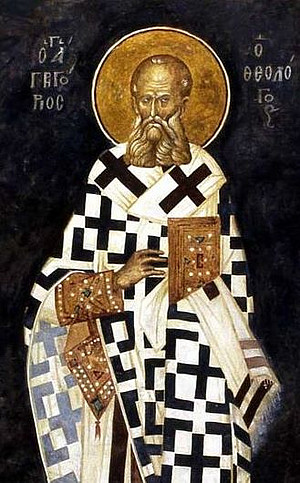Gregory of Nazianzus
A second generation Christian, G.’s father was bishop of Nazianzus. G. had opportunity to receive a first-class education, studying in the best centers for learning of the day, including in Cappadocian Caesarea (where he met Basil), Caesarea Palestine (where he probably made acquaintance with Origen’s works), Alexandria (where he may have studied with Didymus the Blind), and finally in Athens (where he enjoyed the tutelage of two of the finest rhetoricians of the day). After first neglecting ecclesial duties placed upon him by his father by fleeing to Pontus to join B. in monastic retreat (361–62), he took up the priesthood, assisting his father. [Or 4/, 6, 7/8 funeral orations of siblings]. Flight and return [or. 2; 9-11] In 372, B. appointed him bishop of Sasima for political reasons. G., unhappy with this command, never actually filled the office, but remained in Nazianzus. He became the foremost leader of orthodoxy, however, starting in 379 when the Emperor Theodosius named G. leader of a small Nicene community in Constantinople, which largely adhered to Arian creeds. Here, G. delivered his famous “five theological orations” and half of all the orations [20-42] These earned him such esteem as both an orator and theologian that he led the Council of Constantinople in 381, which largely established the doctrine of the divinity of the Holy Spirit. He was even named Bishop of Constantinople for a brief time, but resigned [or 42] when he was unable to resolve the Melitian schism of Antioch. After serving in Nazianzus for a few years, he went into retirement writing poetry and died around 390.
G. leaves behind 44 orations [self-defense (1-3.9-11), attacks (4.5.20.27-31.33), ironical mediation (6.22.23) panegyrics (15.21.24.44) on Christian feasts: major solemnities: Easter (1,44), Nativity (38), epiphany (39), Baptism of Christ, 40, Pentecost (41), encomia of dead (7.8,18,43)], a polished corpus of letters [first Christian author to edit them], and many verses of poetry. His works became the model for Byzantine oratory in style and the standard for Trinitarian theology in content. According to the former, G. revived Attic Greek, classical poetic meter and rhetorical style. According to the latter, G. couched his doctrine of the Trinity and his Christology in soteriological context. Along with B. he asserted the incomprehensibility of God’s nature, but declared He had made His existence and attributes known in salvation history. The one God is known by his three-fold activity in salvation: the ungenerate Father sending the only-begotten Son followed by the “spiration” (ekporeusis) of the Spirit. In Christology, G. asserted that the Logos must assume the flesh—both body and reason contra Apollinaris—because “what was not assumed was not healed.” Soteriological dimension. Two natures in one person.
He was recognized in his time and shortly thereafter as clearly stating the orthodox faith. O qeolo,goj. Jerome greatly respected him and the Council of Constantinople acknowledged their indebtedness to him in their formulation of the doctrine of God, especially of the Holy Spirit. G. is enshrined as one of the “three hierarchs” of the Orthodox church, one of the four doctors of the East in Roman Catholic tradition, and Protestant theologians tend to rely on him for Trinitarian doctrine more than any of the church fathers.
